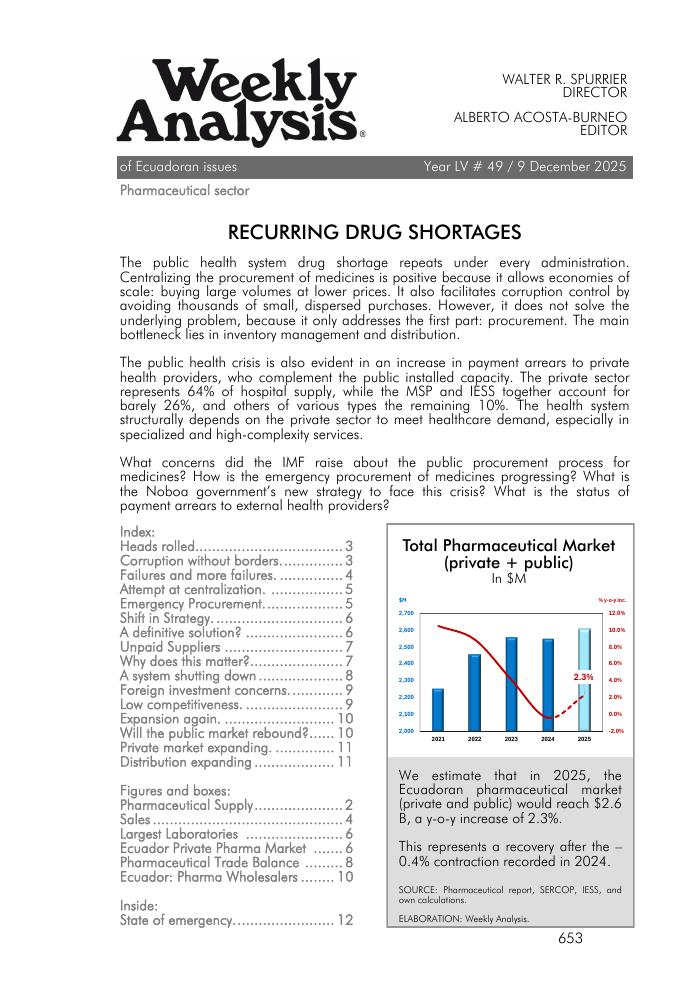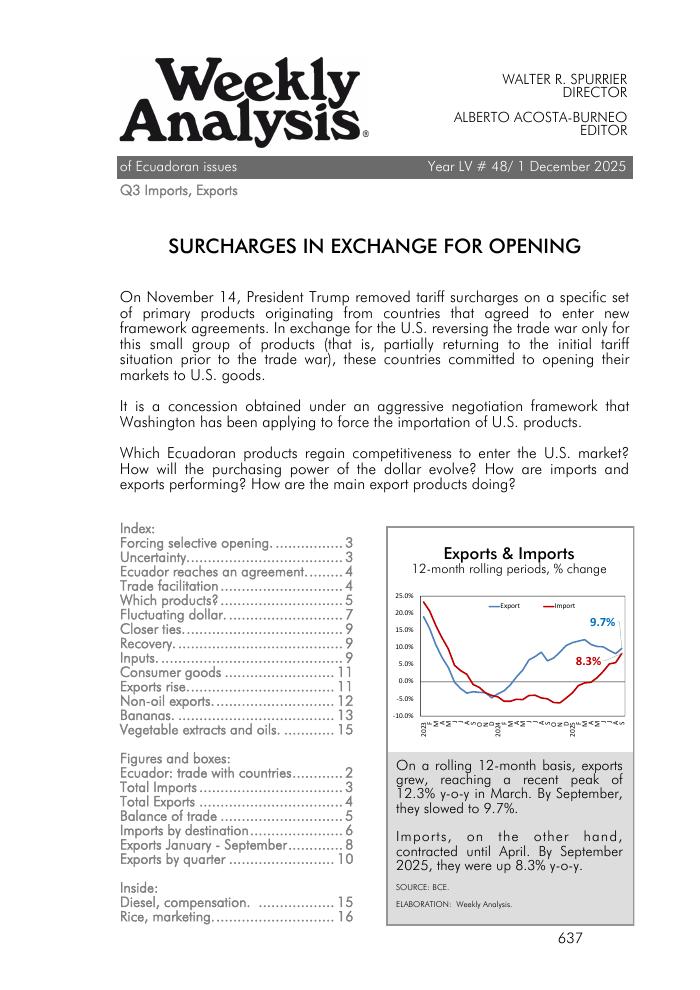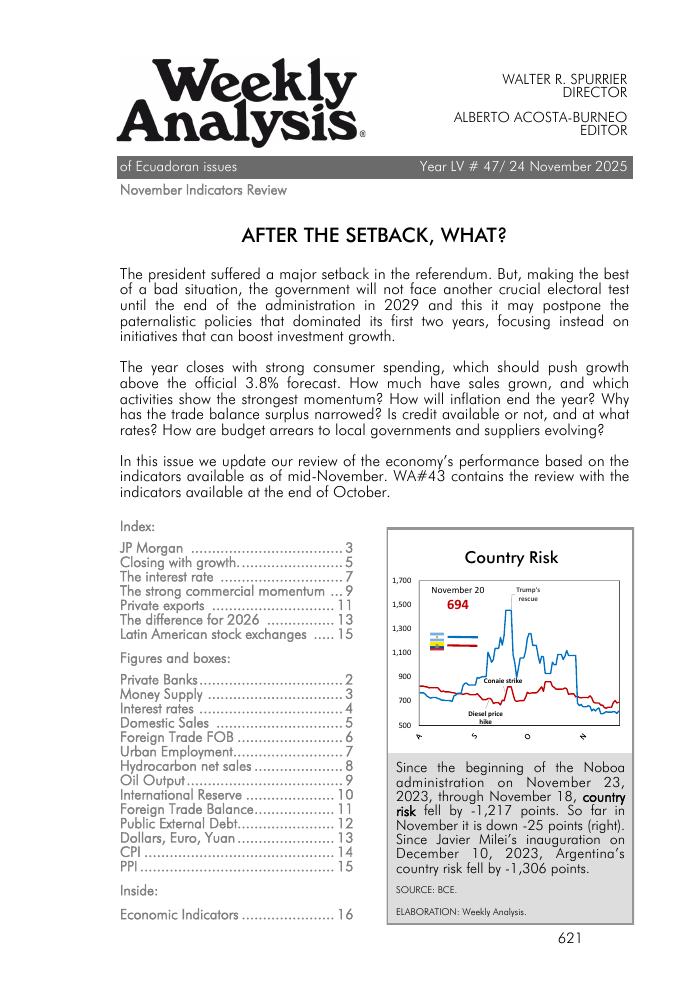Welcome to Grupo Spurrier
Grupo Spurrier is the leading company in the provision of strategic information on economic and political issues regarding Ecuador, which we monitor through Weekly Analysis and Análisis Semanal. We specialize in economic research, competition advice, market research, business plans, and workshops in economic scenarios and regulatory changes.
Weekly Analysis Briefs

WA-2025-49: RECURRING DRUG SHORTAGES
The public health system drug shortage repeats under every administration. Centralizing the procurement of medicines is positive because it allows economies of scale: buying large volumes at lower prices. It also facilitates corruption control by avoiding thousands of small, dispersed purchases. However, it does not solve the underlying problem, because it only addresses the first part: procurement. The main bottleneck lies in inventory management and distribution. The public health crisis is also evident in an increase in payment arrears to private health providers, who complement the public installed capacity. The private sector represents 64% of hospital supply, while the MSP and IESS together account for barely 26%, and others of various types the remaining 10%. The health system structurally depends on the private sector to meet healthcare demand, especially in specialized and high-complexity services. What concerns did the IMF raise about the public procurement process for medicines? How is the emergency procurement of medicines progressing? What is the Noboa government’s new strategy to face this crisis? What is the status of payment arrears to external health providers?

WA-2025-48: SURCHARGES IN EXCHANGE FOR OPENING
On November 14, President Trump removed tariff surcharges on a specific set of primary products originating from countries that agreed to enter new framework agreements. In exchange for the U.S. reversing the trade war only for this small group of products (that is, partially returning to the initial tariff situation prior to the trade war), these countries committed to opening their markets to U.S. goods. It is a concession obtained under an aggressive negotiation framework that Washington has been applying to force the importation of U.S. products. Which Ecuadoran products regain competitiveness to enter the U.S. market? How will the purchasing power of the dollar evolve? How are imports and exports performing? How are the main export products doing?

WA-2025-47: AFTER THE SETBACK, WHAT?
The president suffered a major setback in the referendum. But, making the best of a bad situation, the government will not face another crucial electoral test until the end of the administration in 2029 and this it may postpone the paternalistic policies that dominated its first two years, focusing instead on initiatives that can boost investment growth. The year closes with strong consumer spending, which should push growth above the official 3.8% forecast. How much have sales grown, and which activities show the strongest momentum? How will inflation end the year? Why has the trade balance surplus narrowed? Is credit available or not, and at what rates? How are budget arrears to local governments and suppliers evolving? In this issue we update our review of the economy’s performance based on the indicators available as of mid-November. WA#43 contains the review with the indicators available at the end of October.

WA-2025-46: RECOVERING TIME LOST
The renewal of spectrum for the Advanced Mobile Service (SMA) accumulated four years of delay, worsening the country’s technological lag in mobile speed, 5G deployment, and network modernization. As a result, Ecuador fell to 16th place out of 18 Latin American countries in average mobile internet speed, ahead only of Venezuela and Bolivia. The recent renewal and the upcoming allocation of new bands to operators with investment capacity will allow the country to recover lost ground, expand 4G capacity, and finally enable full 5G deployment—an essential technology for industrial applications and digital innovation. How has telecommunications regulation changed in 2025, and how competitive is today’s regulatory environment? What does it mean that telecommunications are a “strategic sector” under the Constitution? Why does CNT continue to post multimillion-dollar losses despite the privileges granted by law as a public company? And why is the State using CNT so intensively for new technological projects across various institutions?

WA-2025-45: THE HARDEST PART IS DONE
The president has learned to make intensive use of public spending to manage his approval rating. The presidential reelection came at a high fiscal cost. More recently, the targeting of the diesel subsidy was accompanied by an aggressive program of fiscal transfers to mitigate rejection of the measure. Overall, current spending increased by $1.6B through October, and public investment rose by $285M. Once again, the 2026 Bill of the Budget looks like a catalog of impossible aspirations. Although the Constitution requires annual increases in health and education spending, in practice, resources are never sufficient and actual allocations remain far below what is promised. The fiscal consolidation target under the IMF program (2024–28) is 6.6% of GDP. Noboa’s government has been very efficient in fiscal adjustment—so much so that, just two years into a five-year program, it has already completed the equivalent of 3.5 percentage points of GDP, leaving 3.2 additional points to be achieved over the next three years. The toughest part of the adjustment is already over. What measures can be expected going forward?

WA-2025-44: BEST YEAR EVER?
President Noboa took to the X platform to demand that private banks advance the payment of the thirteenth-month salary, asserting that they had experienced their best year in history. In reality, sales are growing across all sectors of the economy (with the exception of oil), not just banking. As of September, domestic sales grew by 10% y-o-y on average. Although ROE rose to 12.6% in September, it is still lower than 2023 or pre-pandemic levels. The new Reform Law to the Monetary and Financial Code, approved in October 2025 following the declaration of unconstitutionality of the Public Integrity Law, redefines the governance of the Ecuadoran financial system. What does it imply for the financial system? Why do interest rates continue to drop across the board? How has the financial system's liquidity evolved? Will Panama's exclusion from the list of tax havens mark a new cycle of financial integration and reduction of funding costs for the country? How do the banks rate for their efficiency, capitalization, earnings, and liquidity according to the CAMEL analysis?


